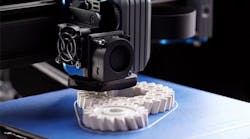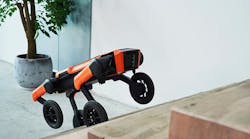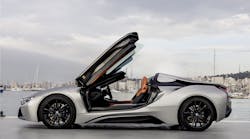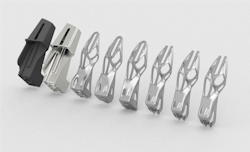The Altair Enlighten Awards, which honor advances in lightweighting technology, are the automotive industry’s equivalent of The Biggest Loser. This year, General Motors took top honors at the awards ceremony, where there was more than one joke about how the unwieldy plastic trophy could have benefited from the latest in lightweighting technology. GM winnowed the weight of its 2019 Chevy Silverado by 9%—450 lbs. less than the 2018 version—with the help of thinner, stronger new steels, unspecified “new assembly processes” and computer simulation that models the best thickness for each part to meet safety and other requirements.
But the real stunner that day was a roof bracket, small enough to fit in the pocket of Maximilian Meixlsperger, the head of metal additive manufacturing at BMW who designed it. Meixlsperger showed the silver bauble to whomever asked during his short window of time in Traverse City, Michigan, before he caught the next plane to Europe. (The awards, sponsored by the company that designs much of the engineering software for lightweighting, were part of the Center for Automotive Research’s annual Management Briefing Seminars, a summertime reunion for auto executives from around the world.)
Meixlsperger’s proud-papa vibe was understandable: He had spent 10 years, off and on, tinkering with the design, before 3-D printing technology finally caught up with his ambitions—and in three months’ time, production ramped up and the part was produced for the 2018 BMW i8 Roadster.The roof bracket—the mechanism that makes the soft top on the Roadster rise and lower, fold and unfold, quickly in a zigzag configuration—is the first 3-D printed metal component that has been successfully mass-produced, albeit in low volumes. It is also 44% lighter than the conventionally manufactured roof bracket for the previous Roadster model.
“When the judges looked at this part, we said, ‘this is the tip of the iceberg for manufacturing,’” said Richard Yen, Altair senior vice president for global automotive and industry and one of a team of judges for the award across industry, from Japan, China, the U.S., Germany and the UK.
The part needed to lift, push and pull the weight of the roof, requiring a complex sculptural structure that was impossible to cast. Using topology optimization software in this type of challenge, engineers and designers can input specs like the weight of the load they need to move and the space they have, and the software will generate a “load path”—a design that distributes the load to minimize the amount of material required in the part.
Often, the load path is just a good idea on a screen that cannot be efficiently translated into an object. More complicated designs require extra support during the 3-D printing process to maintain structural integrity. That support takes up additional space and adds steps to the production process—such as removing the support with another machine, plus additional refinishing and polishing. This made production too costly and lengthy to be feasible.
Meixlsperger’s design overcame those structural challenges. “What BMW did is get this done without support,” said Yen. “Now they can print one batch at a time for mass production, They can print more than 600 of these brackets in one batch.”











